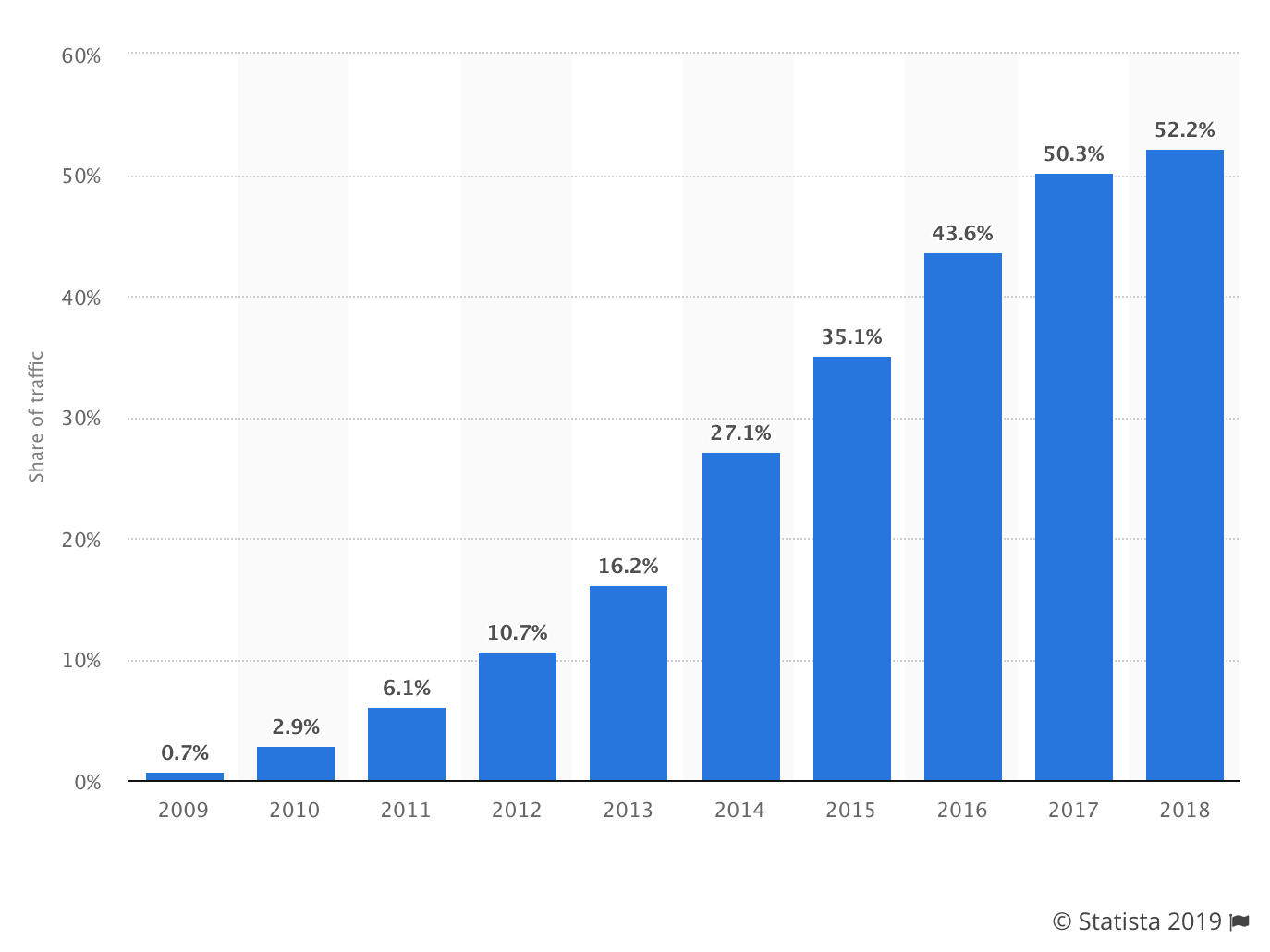67% of the world now owns a mobile phone (Source: Statista). And the number of mobile users is expected to pass the five billion mark in 2020 — making it one of the technologies with the fastest adoption rates in human history.
Percentage of all global web pages served to mobile phones 2009-2018
 Figures show the unprecedented growth in mobile in the last decade
Figures show the unprecedented growth in mobile in the last decade
Plus, as a result of these sales, global mobile data traffic is projected to increase by 750% from 2016 to 2022 too (Source: MarketingLand).
This growth will be spread evenly across the world, and roughly 50% of this new traffic will be driven by video content alone — so get ready!
Accordingly, with the adoption of all these new smart devices, the share of mobile commerce in all eCommerce is expected to rise to 75% by 2022 as well (Source: Statista). It’s the emerging markets where the majority of the eCommerce growth is expected. India, South East Asia & Latin America being earmarked as the booming transaction hot spots.
So what’s changed?
Long gone are the days when mobile used to be an asset of the privileged classes. There’s now substantial competition between companies and prices have tumbled accordingly. A fully-featured smartphone is now yours to buy from as little as $100. As a result, the desktop, laptop and tablet markets have seen a slow and steady decline since the mobile boom of 2012.

The technologies related to smartphones, be it in software or hardware, are developing rapidly year on year. Phones with bigger screens enhance the experience, and the latest processors mean it’s now unlikely to encounter frustrating delays when browsing or using applications.
More importantly, the pocket-friendly nature of the device means its available 24/7 (unlike the tablet, laptop & desktop). Most people don’t leave home without it and now feel a sense of dread when it’s misplaced or forgotten. The mobile phone is not going anywhere (unless it’s in your pocket!).
The youth of today use smartphones for simply passing time and maintaining their social standard. The instant gratification generation has expectations of being able to browse or shop at any point in time — and this can only really be satisfied with mobile. With a mobile phone in hand, internet access is a must and this feeling of disconnection when it’s not there is becoming the norm. Internet addiction disorder is a real thing!
M-commerce?
Consumers always used to wait to reach their computer to make a purchase, but now we just can’t wait… and we don’t have to! Along with the newly affordable prices for feature-rich mobile devices, there is also an increasing comfort in spending money online, which means mobile transactions are outweighing everything else in most verticals.
With the average smartphone screen size now approaching 6 inches, mobile usage pattern has completely changed. Online shopping is one of the major trends and beneficiaries set by these bigger screens.
Improvements over the last 5 years in mobile UI have seen the size, shape, padding, use of colour, etc all adapting and dramatically improving the general usability on small screen devices. This is in conjunction with the removal of clutter and giving users visual feedback, which has led to a much-increased confidence in successful browsing and purchasing online.

Single-click checkout options are one of the new prominent features that mobile shopping has embraced. Anyone who has managed to use Apple Pay or Google Pay on an eCommerce site — checking out using their fingerprint — will testify that it instantly feels like the future. The glorious and labourious past of having to enter the delivery address, billing address and credit card details feels embarrassingly archaic almost immediately.
One example which highlights the world’s movement towards mobile is Flipkart, one of India’s largest e-retailers, who wasn’t even offering discounts to desktop users during its Diwali sale. To find a bargain, users had to download the company’s app. Building on this precedent, Myntra, (a fashion portal owned by Flipkart), went even further, and actually closed its desktop and mobile websites. It’s now an app-only service — just like Uber. So, India is transitioning from a mobile-first to a mobile-only country. This undoubtedly puts them at the leading edge of a global trend.

At present, the thought of buying a car or a house through a phone still seems unlikely. But in another decade, and if things continue at the current pace — it might not seem that odd at all…
At Vaimo we help brands, retailers and manufacturers all over the world to drive success in digital commerce. Reach out to us if you want to hear more about how we can help drive your mobile commerce strategy for business success!








